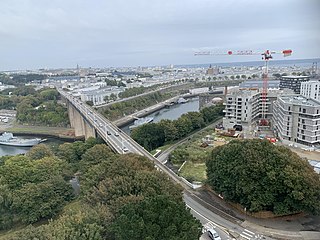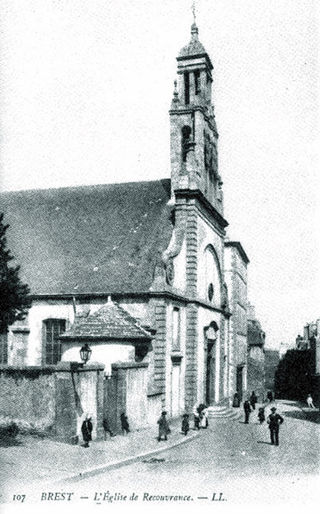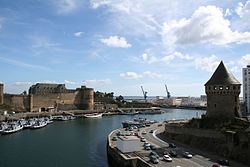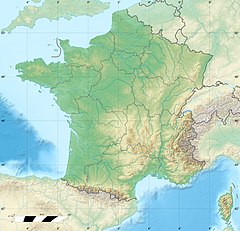
Brest is a port city in the Finistère department, Brittany. Located in a sheltered bay not far from the western tip of a peninsula and the western extremity of metropolitan France, Brest is an important harbour and the second largest French military port after Toulon. The city is located on the western edge of continental France. With 139,456 inhabitants (2020), Brest forms Western Brittany's largest metropolitan area, ranking third behind only Nantes and Rennes in the whole of historic Brittany, and the 25th most populous city in France (2019); moreover, Brest provides services to the one million inhabitants of Western Brittany. Although Brest is by far the largest city in Finistère, the préfecture of the department is in the much smaller town of Quimper.

Pontivy is a commune in the Morbihan department in Brittany in north-western France. It lies at the confluence of the river Blavet and the Canal de Nantes à Brest. Inhabitants of Pontivy are called Pontivyens in French.

The Blavet river flows from central Brittany and enters the Atlantic Ocean on the south coast near Lorient. It is 148.9 km (92.5 mi) long. The river is canalised for most of its length, forming one of the links in the Brittany canal system. It connects with the Canal de Nantes à Brest at Pontivy and runs to Hennebont, a distance of 60 km. From the last lock at Polvern, the river is tidal and considered as a maritime waterway, giving access to the seaport of Lorient and the Atlantic Ocean. It became more important when the western half of that system was cut off by the construction of the Guerlédan dam and hydropower plant. Today, boats coming from Nantes via Redon have to take the Canal du Blavet in order to reach the ocean near Lorient.
The battle of Brest, sometimes called the battle of the River Penfeld, was an action in 1342 between an English squadron of converted merchant ships and that of a mercenary galley force from Genoa fighting for the Franco-Breton faction of Charles of Blois during the Breton War of Succession, a side conflict of the Hundred Years War.

Landerneau is a commune in the Finistère department of Brittany in north-western France.

The 380mm/45 Modèle 1935 gun was a heavy naval gun of the French Navy. It was the largest calibre naval gun ever fielded in French service.

The rue de Siam is the main arterial street of Brest, a port city in Brittany, France. Its name comes from the arrival of three ambassadors led by Kosa Pan, sent by the King of Siam on the 29 June 1686 to meet Louis XIV in Versailles. They went with six mandarins, three translators, two secretaries and a retinue of servants, loaded with presents. They traveled on the boats l'Oiseau and La Maligne.
Landévennec is a commune in the Finistère department of Brittany in north-western France.

The roadstead of Brest is a roadstead or bay located in the Finistère department in Brittany in northwestern France. The surface area is about 180 km². The port of Brest and one of the two French naval bases, Brest Arsenal, are located on its northern edge. It is linked to the Atlantic Ocean by the Goulet de Brest, a strait about 1.8 km wide. Three main rivers drain into the roadstead: the Penfeld, the Élorn and the Aulne.

The Élorn is a 56.4-kilometre (35 mi) long river in Brittany, France. Its source is in the monts d'Arrée, 1.5 kilometres (0.9 mi) north-northeast of Le Tuchenn Kador, and it then runs through several small towns such as Sizun and Landivisiau before flowing out into the roadstead of Brest.

The Pont de l’Harteloire is a bridge in Brest, France. Upstream of the Pont de Recouvrance, it connects the two banks of the river Penfeld and overlooks the arsenal de Brest. It is on the site the naval transporter bridge was destroyed during the Second World War.

The Pont de Recouvrance is a vertical-lift bridge in Brest, France, across the river Penfeld. Opened on 17 July 1954, it was the largest vertical-lift bridge in Europe until the opening of the Rouen Pont Gustave-Flaubert in 2008. It links the bottom of the rue de Siam to the quartier de Recouvrance, replacing a swing bridge destroyed by Allied bombardment in 1944.

Recouvrance is the section of the city of Brest, France, on the right bank of the River Penfeld. The popular and historically-Breton quarter is in contrast to the largely-Francophone quarter of Brest-même or Brest-proper, on the left bank.

The Pont National was a swing bridge across the river Penfeld in Brest, France. It opened in 1861 and linked rue de Siam to Recouvrance, near the Tour Tanguy. It was destroyed by Allied bombardment in 1944 and was replaced by the Pont de Recouvrance in the 1950s.

The Tour Tanguy, Bastille de Quilbignon or Tour de la Motte Tanguy is a medieval tower on a rocky motte beside the Penfeld river in Brest, France. Probably built during the Breton War of Succession, it faces the château de Brest and is now accessed by a road off the square Pierre Péron, at one end of the pont de Recouvrance. It now houses the Museum of Old Brest, a museum with a collection of dioramas that depict the city of Brest on the eve of World War II.

The Château de Brest is a castle in Brest, Finistère, France. The oldest monument in the town, it is located at the mouth of the river Penfeld at the heart of the roadstead of Brest, one of the largest roadsteads in the world. From the Roman castellum to Vauban's citadel, the site has over 1700 years of history, holding right up to the present day its original role as a military fortress and a strategic location of the highest importance. It is thus the oldest castle in the world still in use, and was classified as a monument historique on 21 March 1923.

The Brest Arsenal is a collection of naval and military buildings located on the banks of the river Penfeld, in Brest, France.

The Brest tramway located in Brest, Brittany, France consists of a 28-stop, two-branch, 14.3-kilometre (8.9 mi) line connecting Porte de Plouzané in the west with Porte de Gouesnou and Porte de Guipavas northeast of the city centre. The end-to-end journey takes 38 minutes. It's operated by RD Brest, and it's part of the Bibus network. The system began service on 23 June 2012. It is expected to serve 50,000 passengers per day. The line is the successor to a tram network that operated in Brest from 1898 to 1944. The network has the distinction of being trilingual.
The following is a timeline of the history of the city of Brest, France.

The Brest International Maritime Festival is a gathering of traditional boats from around the world, taking place for a week every four years in the city of Brest in France.




















